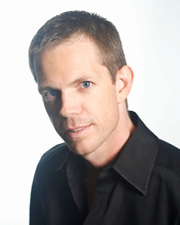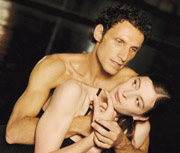Dominic Does Diaghilev
Photo by Gariella Nissen

In mid-August, I visited the studio of the Dominic Walsh Dance Theater, where Walsh was leading his company through an early rehearsal for their upcoming show, 1909–2009: The Great Collaborators of the Ballets Russes. That day I simply watched and took in the process of teaching a company a piece of choreography. Two weeks later, I had a phone conversation with the choreographer about his company and the show, which is a 100th anniversary tribute to Sergei Diaghilev and the landmark company he founded, the Ballet Russes.
Neil Ellis Orts: The rehearsal I saw was of you teaching the company your version of La Spectra de la Rose. It was fun for me to watch highly trained dancers learn new choreography. It reminded me how hard even the highly trained work with new material.
Dominic Walsh: That piece in particular is a piece where you need to have an incredibly strong classical technique. Then I’m asking them to add all sorts of other movement that challenges that technique, but it actually is all pretty organic movement. I use a lot of natural spirals and natural circles and things like that, but sometimes, because we’re classically trained and we’re so specific, sometimes it’s hard to trust that the technique will maintain while we totally let go and become passive to the phrase of movement. That piece is very intricate.
How long have you worked with these dancers?
With Domenico [Luciano], my lead dancer, it’s been about five years; Lauren [Bettencourt], it’s about a year and a half. All the rest are new as of this season.
So mostly new people. That’s really interesting to me, because I saw a lot of nonverbal communication. I saw someone make gestures in the air like they were asking a question, and then you made other gestures, and then you both nodded. Does that sort of silent communication happen a lot?
When you’ve been in the profession a long time, you end up kind of speaking the language of gesture. Once you’ve done a couple billion different steps in your life [laughs], you really start to understand the subtle differences between positions and movements and where the movement comes from and what it means. So there’s quite a lot that we use to communicate that is much more profound than what words can provide for us.
Talk a little bit about the impact of Diaghilev and the Ballet Russes on 20th-century ballet.
A hundred years ago, it was so profound what they were doing; it was so avant garde. It was a combination of tremendous artistic forces with the artists and composers and dancers and choreographers, brought together with the real intent of doing something fresh. No one was saying, “Oh, why don’t you do that old one that you did? We like that old, pretty one.” There was such an energy at that time of revolutionizing and trying to reinvent art and theater by this spirit of collaboration.
Tell us a bit about your versions of the four pieces in this program. Some are closer to the source material than others, I understand.
With Spectra de la Rose, I actually wanted to pay homage to it rather than recreate the whole idea, so there are some of the hand movements that are actually similar, with that same kind of spirit and that same kind of romance, but, obviously, the steps are quite different. With The Afternoon of a Faun, I’m using the imagery of Rodin’s [sculpture of] Nijinsky to kind of create ideas and imagery around the faun.
Does your Faun retain the scandalous and graphic sensuality of the original?
The story is about his discovering that part of himself, and the imagery of Rodin’s faun provided such physicality and a kind of confinement that I thought was very interesting. So there’s also a layer of the faun being Nijinksy, of course, and being a little bit manipulated by Diaghilev or just the world. He had a very hectic schedule and did tons of performances, and his career was very short. But he was a huge star. He was always on and never really took any down time. I thought that imagery would be a kind of interesting double look at both the faun and the music and the story of the faun, while also making references to the confinement that he was feeling.
And The Dying Swan?
I read last night a quote from Allegra Kent: “The dying swan is not about a woman impersonating a bird; it’s about the fragility of life, all life, and the passion with which we hold onto it.” In my version, the woman is in cocktail attire, and she comes back to her room and she finds that her husband has left her. So we see a bit of her fragility for sure, and then she kind of gathers it up and moves on.
And that leaves The Firebird.

My idea of the firebird is much more psychological. There are no big red tutus, I can tell you. I’m kind of using the firebird as a sense of self. Sometimes if you’ve been in a relationship for a long time, or you have kids or something, you kind of think, “Am I still me? Am I still that person I was when I was young? Am I still that vibrant independence, that uniqueness, that ambition for life? Does that still exist in me, or am I just fulfilling my duties as a husband or wife or parent?” So that’s kind of the angle that we took, and the firebird is that spark within, that sense of self. In our version, there is a couple that has been together for a very long time, and a secret arises, and it’s how they deal with this angst of being a little dissatisfied with who they feel they are now and how they deal with this secret.
1909–2009: The Great Collaborators of the Ballets Russes (which also features guest artist Marie-Agnès Gillot, of the Paris Opera Ballet) is presented Oct. 15–17, at 7:30 p.m. at the Hobby Center for the Performing Arts, Zilkha Hall. Details: dwdt.org or
713/315-2525.
Neil Ellis Orts also writes about Derek Webb in this issue of OutSmart magazine.
__________________________
SIDEBAR
Black Russian
The dark brilliance of Ballet Russes’ Serge Diaghilev
by Theodore Bale
When writer and former ballerina Toni Bentley spoke at the recent Harvard symposium on Diaghilev, she mentioned his “signature Susan Sontag hair” and asked “Does that happen only to brilliant homosexuals?” Today, most of the images circulating on the web show the legendary impresario with that distinctive white stripe punctuating a shock of black hair, his dress always formal, with monocle and cane, and his gaze mysterious and piercing.
Born in 1872 to a wealthy Perm family, Sergei Pavlovich Diaghilev was described as an “apple-cheeked young country bumpkin” (by biographer Arnold L. Haskell) when he appeared in St. Petersburg in 1890. He would become one of the most prominent members of the Russian intelligentsia, an aesthete in the tradition of the German romantics and later Oscar Wilde, outspoken and passionate about art for art’s sake. His unprecedented journal, Mir Isskustva (The World of Art), established him as a maker of taste.
By 1906, the failed composer (he had studied with Rimsky-Korsakov, who was less than enthusiastic) had proven himself as a producer, having brought a weighty exhibit of Russian art to the Petit Palais in Paris. Opera and ballet performances soon followed, making Sergei the darling of Paris and today one of the fathers of modernity in art and performance. He was skilled at realizing collaborations, commissioning ballet scores from such composers as Stravinsky, Ravel, Debussy, Prokofiev, and Richard Strauss, as well as set and costume designs from Picasso, Bakst, Miró, and many others. He is said to have been thrilled over the scandalous premiere of Le Sacre du Printemps in 1913, which marked the beginning of the modern period in dance.
Notoriety surrounded Diaghilev as often as bill collectors and hungry dancers, but he lived for his Ballets Russes and never realized for himself the wealthy milieu from which he came (his family had held serfs). His first lover was his country cousin, “Dima” (Dmitri) Filosofov. Other men followed, most notably the brilliant danseur and fallen choreographer Vaslav Nijinsky, and then the celebrated and glamorous opera singer Boris Kochno (31 years Diaghilev’s junior). Throughout life, Serge suffered hydrophobia (fear of water), ironically passing away due to complications from diabetes in Venice in 1929. He is buried in the Russian sector of the cemetery island, San Michele, just a short gondola ride away, where devotees still offer roses and pointe shoes at his grave.
Theodore Bale is a critic, journalist, and musician based in Cambridge, Massachusetts. His writing has appeared in Dance Magazine, the Boston Herald, Dance International, and Dance Chronicle.










